The Intel Broadwell Desktop Review: Core i7-5775C and Core i5-5675C Tested (Part 1)
by Ian Cutress on June 2, 2015 7:45 AM ESTGaming Benchmarks: High End
Last but certainly not least, we have our gaming benchmarks with our high-end Radeon R9 290X and GeForce GTX 980 video cards. Depending on the settings used, we can end up outright CPU limited here if the dGPUs don't become the bottleneck first.
Alien: Isolation
If first person survival mixed with horror is your sort of thing, then Alien: Isolation, based off of the Alien franchise, should be an interesting title. Developed by The Creative Assembly and released in October 2014, Alien: Isolation has won numerous awards from Game Of The Year to several top 10s/25s and Best Horror titles, ratcheting up over a million sales by February 2015. Alien: Isolation uses a custom built engine which includes dynamic sound effects and should be fully multi-core enabled.
For low end graphics, we test at 720p with Ultra settings, whereas for mid and high range graphics we bump this up to 1080p, taking the average frame rate as our marker with a scripted version of the built-in benchmark.
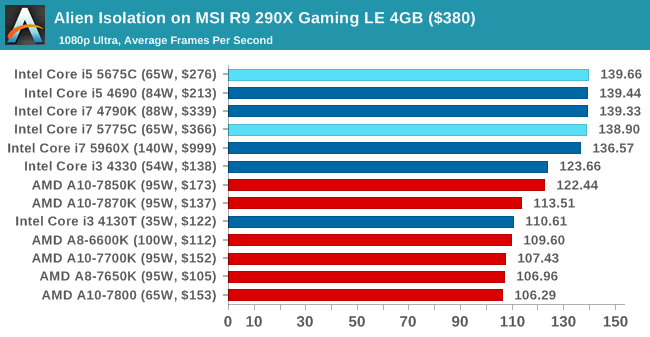
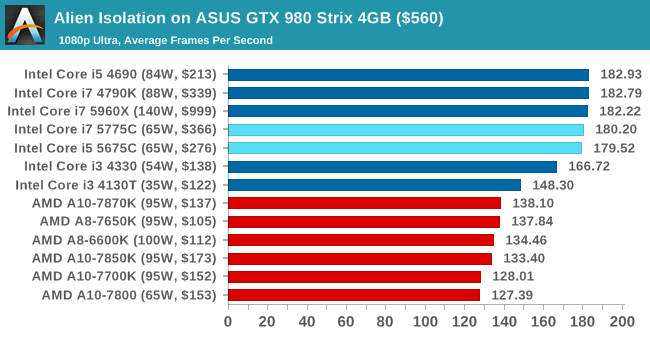
Total War: Attila
The Total War franchise moves on to Attila, another The Creative Assembly development, and is a stand-alone strategy title set in 395AD where the main story line lets the gamer take control of the leader of the Huns in order to conquer parts of the world. Graphically the game can render hundreds/thousands of units on screen at once, all with their individual actions and can put some of the big cards to task.
For low end graphics, we test at 720p with performance settings, recording the average frame rate. With mid and high range graphics, we test at 1080p with the quality setting. In both circumstances, unlimited video memory is enabled and the in-game scripted benchmark is used.
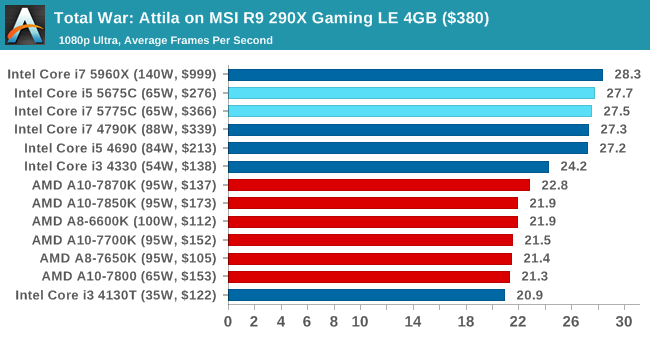

Grand Theft Auto V
The highly anticipated iteration of the Grand Theft Auto franchise finally hit the shelves on April 14th 2015, with both AMD and NVIDIA in tow to help optimize the title. GTA doesn’t provide graphical presets, but opens up the options to users and extends the boundaries by pushing even the hardest systems to the limit using Rockstar’s Advanced Game Engine. Whether the user is flying high in the mountains with long draw distances or dealing with assorted trash in the city, when cranked up to maximum it creates stunning visuals but hard work for both the CPU and the GPU.
For our test we have scripted a version of the in-game benchmark, relying only on the final part which combines a flight scene along with an in-city drive-by followed by a tanker explosion. For low end systems we test at 720p on the lowest settings, whereas mid and high end graphics play at 1080p with very high settings across the board. We record both the average frame rate and the percentage of frames under 60 FPS (16.6ms).

![Grand Theft Auto V on MSI R9 290X Gaming LE 4GB ($380) [Under 60 FPS]](https://images.anandtech.com/graphs/graph9320/74977.png)

![Grand Theft Auto V on ASUS GTX 980 Strix 4GB ($560) [Under 60 FPS]](https://images.anandtech.com/graphs/graph9320/74989.png)
GRID: Autosport
No graphics tests are complete without some input from Codemasters and the EGO engine, which means for this round of testing we point towards GRID: Autosport, the next iteration in the GRID and racing genre. As with our previous racing testing, each update to the engine aims to add in effects, reflections, detail and realism, with Codemasters making ‘authenticity’ a main focal point for this version.
GRID’s benchmark mode is very flexible, and as a result we created a test race using a shortened version of the Red Bull Ring with twelve cars doing two laps. The car is focus starts last and is quite fast, but usually finishes second or third. For low end graphics we test at 1080p medium settings, whereas mid and high end graphics get the full 1080p maximum. Both the average and minimum frame rates are recorded.
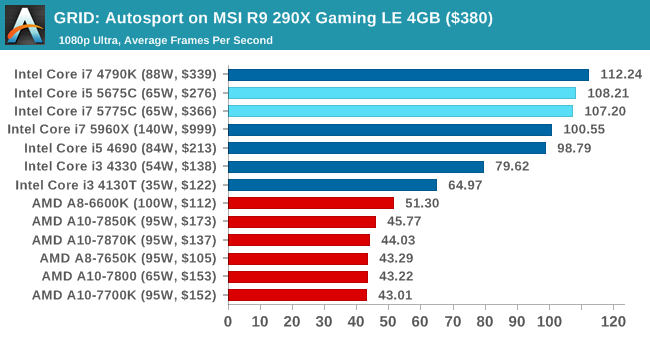
![GRID: Autosport on MSI R9 290X Gaming LE 4GB ($380) [Minimum FPS]](https://images.anandtech.com/graphs/graph9320/74979.png)
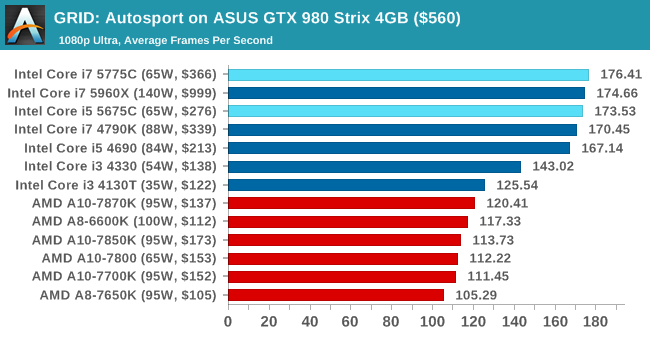
![GRID: Autosport on ASUS GTX 980 Strix 4GB ($560) [Minimum FPS]](https://images.anandtech.com/graphs/graph9320/74991.png)
Middle-Earth: Shadows of Mordor
The final title in our testing is another battle of system performance with the open world action-adventure title, Shadows of Mordor. Produced by Monolith using the LithTech Jupiter EX engine and numerous detail add-ons, SoM goes for detail and complexity to a large extent, despite having to be cut down from the original plans. The main story itself was written by the same writer as Red Dead Redemption, and it received Zero Punctuation’s Game of The Year in 2014.
For testing purposes, SoM gives a dynamic screen resolution setting, allowing us to render at high resolutions that are then scaled down to the monitor. As a result, we get several tests using the in-game benchmark. For low end graphics we examine at 720p with low settings, whereas mid and high end graphics get 1080p Ultra. The top graphics test is also redone at 3840x2160, also with Ultra settings, and we also test two cards at 4K where possible.
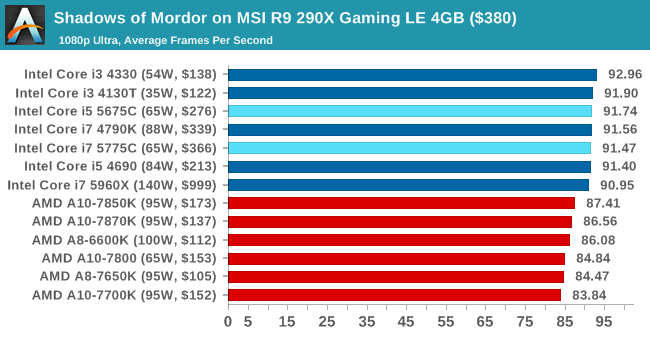
![Shadows of Mordor on MSI R9 290X Gaming LE 4GB ($380) [Minimum FPS]](https://images.anandtech.com/graphs/graph9320/74981.png)
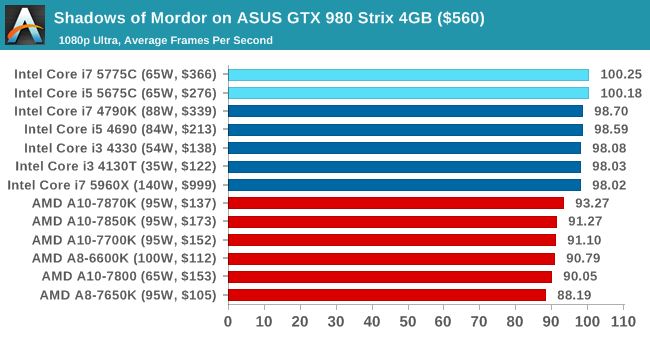
![Shadows of Mordor on ASUS GTX 980 Strix 4GB ($560) [Minimum FPS]](https://images.anandtech.com/graphs/graph9320/74993.png)
Shadows of Mordor at 4K, Single GPU
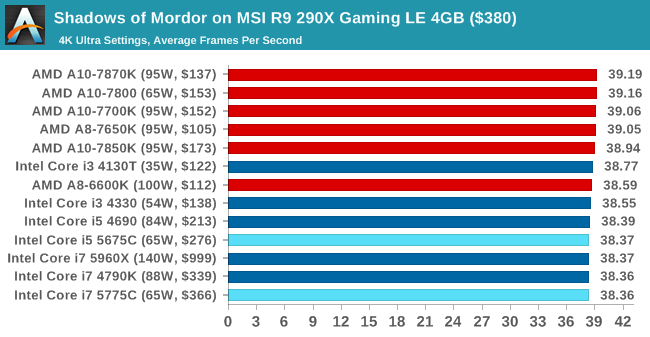
![Shadows of Mordor on MSI R9 290X Gaming LE 4GB ($380) [Minimum FPS]](https://images.anandtech.com/graphs/graph9320/74983.png)
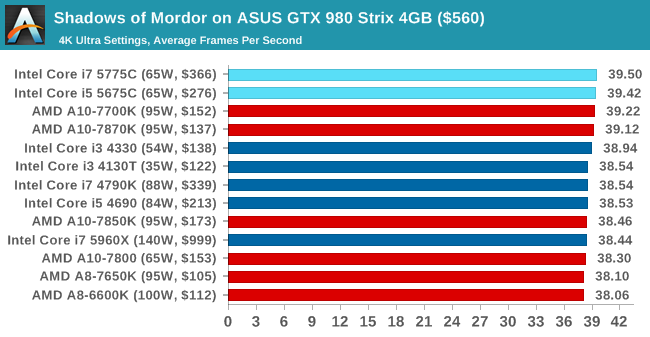
![Shadows of Mordor on ASUS GTX 980 Strix 4GB ($560) [Minimum FPS]](https://images.anandtech.com/graphs/graph9320/74995.png)
Shadows of Mordor at 4K, Dual GPU (Crossfire/SLI)
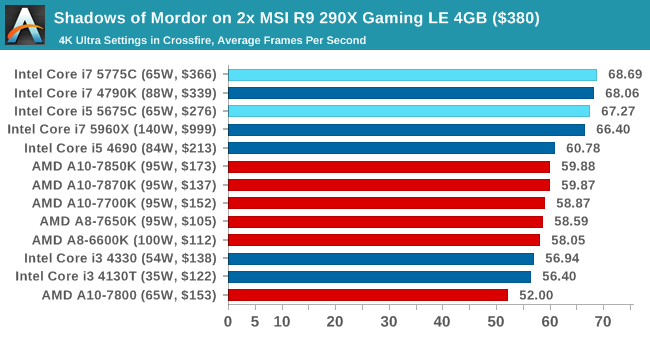
![Shadows of Mordor on 2x MSI R9 290X Gaming LE 4GB ($380) [Minimum FPS]](https://images.anandtech.com/graphs/graph9320/74985.png)
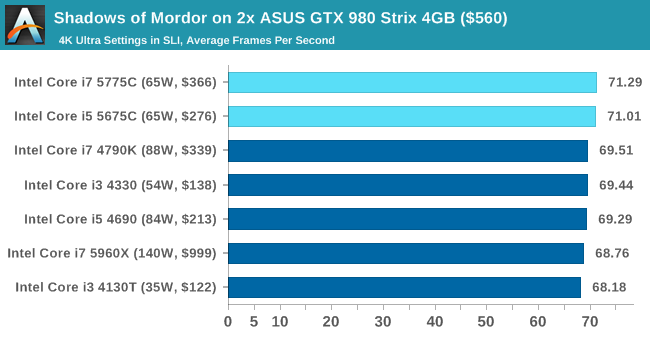
![Shadows of Mordor on 2x ASUS GTX 980 Strix 4GB ($560) [Minimum FPS]](https://images.anandtech.com/graphs/graph9320/74997.png)
Conclusions on High-End Graphics
Once again we aren't seeing levels of performance that Haswell wasn't already hitting, however at the same time the Broadwell SKUs are doing quite well given their lower frequencies and TDPs. Which is going to make overclocking all the more interesting, to see what these chips can reach, and if they can reach past the i7-4770K.















196 Comments
View All Comments
iTon - Saturday, June 6, 2015 - link
i've think AMD products best when used Mantle API. it can boost up to 30% than DirectX API. Otherwise 10% parts of AMD APU had TrueAudio DSP Processor. so it is not 100% CPU and GPUOxford Guy - Saturday, June 6, 2015 - link
Six APUs and not one FX chip in the charts.LAME
Oxford Guy - Saturday, June 6, 2015 - link
Heaven forbid someone might see that you can get a better Cinebench multithread score from a $100 8320E than from a pricey Intel...Oxford Guy - Saturday, June 6, 2015 - link
8320E with 1600 8-8-8-24 RAM at 1585 due to FSB, Cinebench 15 multithreadone core per module, 4.28 GHz, 399
one core per module, 5.02 GHz, 467
3.33 GHz, 540
one module disabled, 5 GHz, 590
3.8 GHz, 608
Intel i7-3770, 3.4 GHz, 662
4.17 GHz, 664
4.2 GHz, 675
4.28 GHz, 683
4.41 GHz, 703
4.56 GHz, 724
4.68 GHz, 743
4.78 GHz, 765
Intel 4770K at 4.4 GHz, 822
Clearly, an overclocked Intel will beat this chip in this test but if you have an Intel that can't be overclocked that may be a different story, depending on the stock clockspeed of the chip. Also, Cinebench is, as far as I know, a test that favors Intel since it relies heavily on FPU. None of the APUs are close to FX's performance so the lack of even one 8 thread FX in the charts is not good.
The single thread performance of FX is particularly weak but it can be improved quite a bit by setting the chip to 1 core per module because high clocks can be achieved with much less heat than when the full 8 threads are enabled. The downside is that multithread performance suffers (in tests like Cinebench that can use all 8 threads... perhaps not so much in programs that max out around 4).
single thread
A10-7850K, 92
4.2 GHz, 99
A10-6800K, 100
4.78 GHz, 111
5 GHz, 118
5.02 GHz, (one core per module), 120
5.21 GHz (only one module enabled), 122
5.17 GHz (one core per module), 122
Intel i7 3770, 3.4 GHz, 138
Intel i7 3930K, 3.3 GHz, 148
Oxford Guy - Saturday, June 6, 2015 - link
highest scoring APU in the multithread test:A10-6800K, 325
sireangelus - Saturday, June 6, 2015 - link
Anand, i'm going to heavly critizice your linux testing method.you go to great lengths to adjust and compensate for turbo modes, but on an ubuntu 11.04 it should completely ignore turbo modes since sandy bridge or does not even know what turbAdvances in the linux kernelo modes are, severely limiting both new intel and amd cpu. Also, the power profile is changed alongside the new intel pstate driver, that greatly improved performance under linux in respect to the past; also, new kernels are optimized for the eDram on the crystal well cpus. I suggest you start moving the whole testing platform to something more current or simply redo tests once a year with an updated kernel. You could use the phoromatic platform to automatize the procedure.
Ramon Zarat - Sunday, June 7, 2015 - link
Please add clock for clock comparison with older Intel CPU! Back to at least Sandy Bridge or even further if possible.ES_Revenge - Sunday, June 7, 2015 - link
So clearly Intel has now topped AMD's one remaining trump card--integrated graphics performance. Of course you're paying over 2x the cost for the privilege. One might argue that you're still getting a much better CPU at the same time, which is true, but most people just look at the absolute cost and the fact that the A10 is not all that bad a CPU.I think this becomes *much* more interesting if/when Intel starts producing *i3* CPUs with Iris Pro. Then it's really game over for AMD, unless Zen is something spectacular to allow them to catch up (or even get close) in CPU performance. AMD could also easily up the SPs in their APUs to something like ~1024 which would give them R7 265/PS4/GTX 750 Ti -class performance. The only problem is AMD hits another hitch there as they don't have the thermal/power envelope to do so given A10s can already throttle the CPU side when the GPU is in heavy use, in order to stay within TDP limits. AMD's lack of power and thermal efficiency with their GPUs (as competent as they are otherwise) also poses a serious problem in putting the same tech on an APU die.
Seems like AMD has to hit a homerun with both Zen for performance and their GPUs for efficiency in the coming year. However from everything we know about Fiji and the fact that the rest of the [GPU] lineup will be re-brands, it doesn't seem likely. Perhaps it's time to quit the CPU business, lol. Either that or release APUs with high-end graphics, boxed with CLC/AIO liquid coolers (or massive air coolers).
0ldman79 - Sunday, June 7, 2015 - link
I know it's a dead socket, but could we AM3+ users request a CPU be thrown in the mix?I keep reading, keep looking, the reviews look impressive, so I check the Anandtech Bench and my 6300 is still faster than the APU's.
In all honesty, that has to hurt AMD. Those of us that went with the "big boy socket" are still faster overall even though the APU has made big leaps in IPC and clock speed.
Fact is we're still out here and the only way to get faster across the board is to jump Intel.
ES_Revenge - Monday, June 8, 2015 - link
Well keep in mind your FX 6300 has two more cores (or one more module) and it has 8MB L3 compared to no L3 at all on the APUs. If they made a "6 core" APU with L3 on Kaveri/Godavari it would be faster.. at least until it starts hitting the TDP limits, lol. This of course is probably why there are no 6 or 8 CPU-core APUs--because they're already having problems with keeping TDP within limits with a 512SP GPU and 4-core CPU.